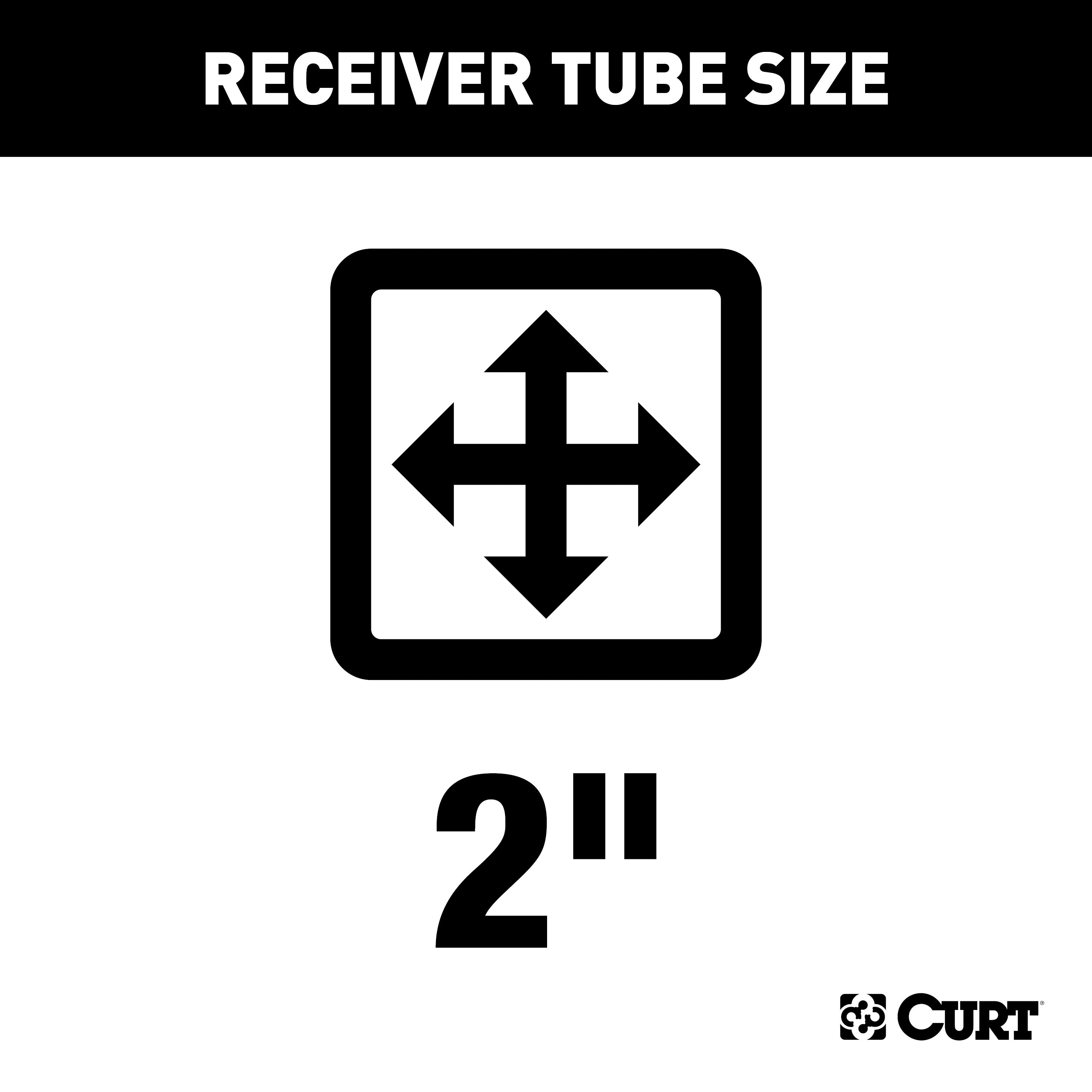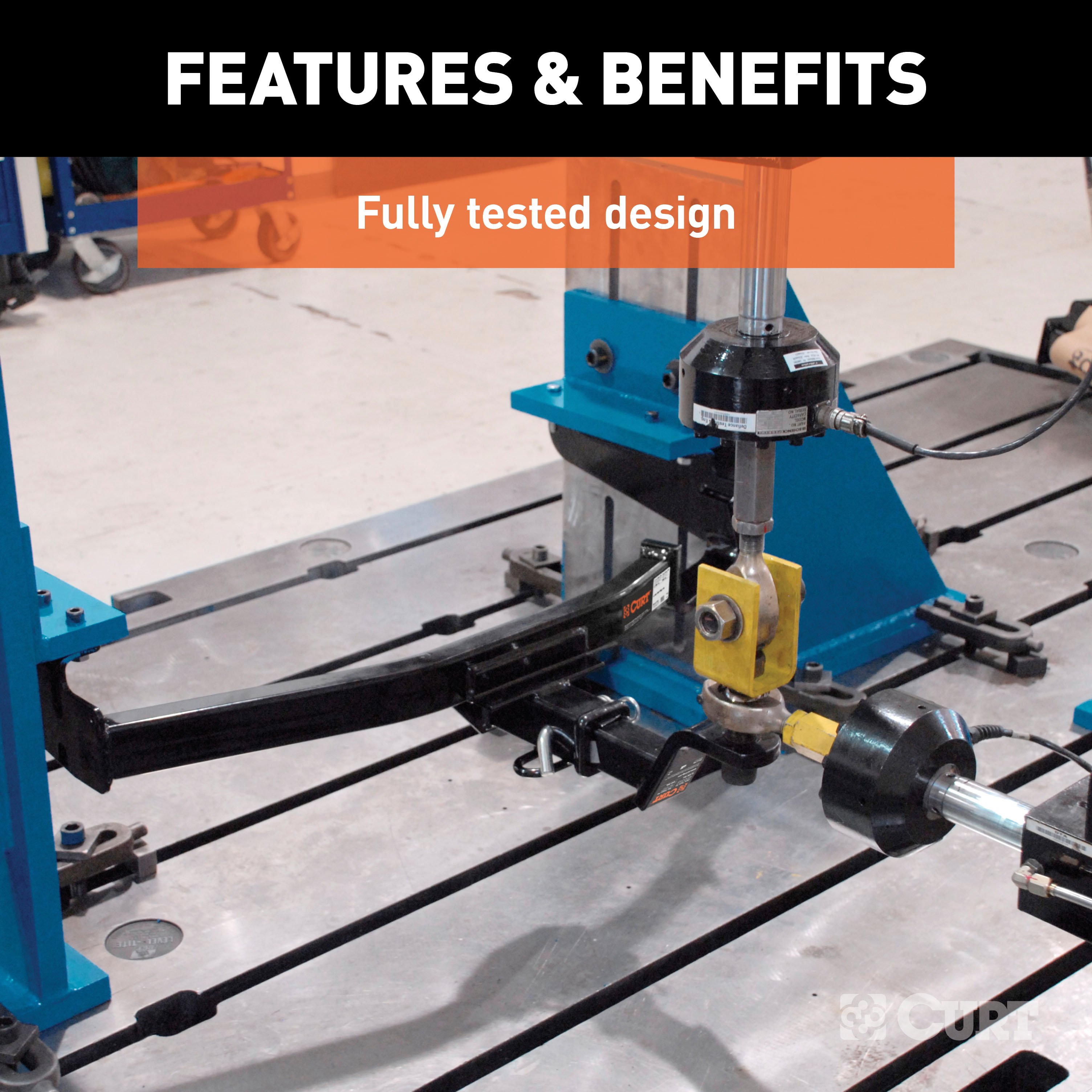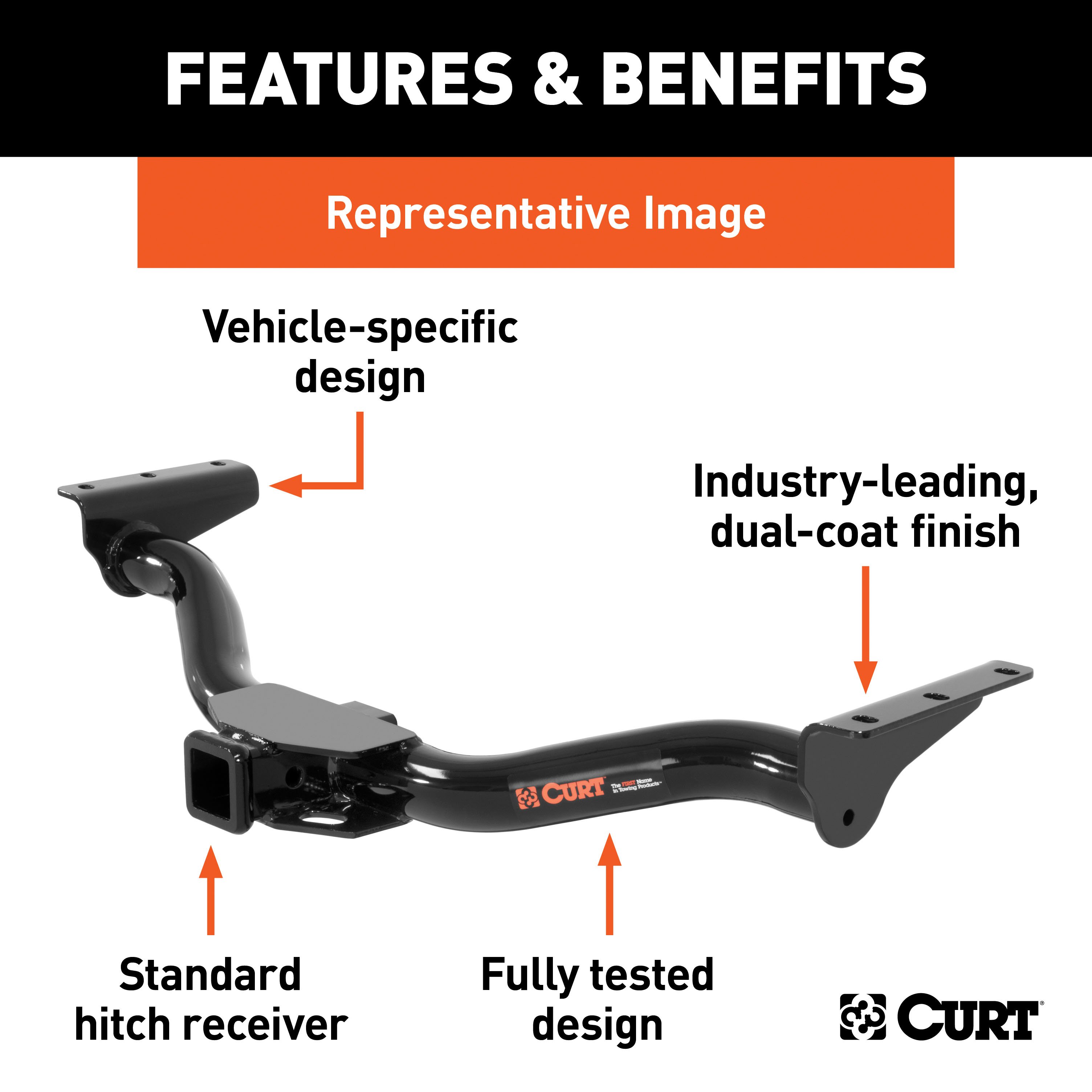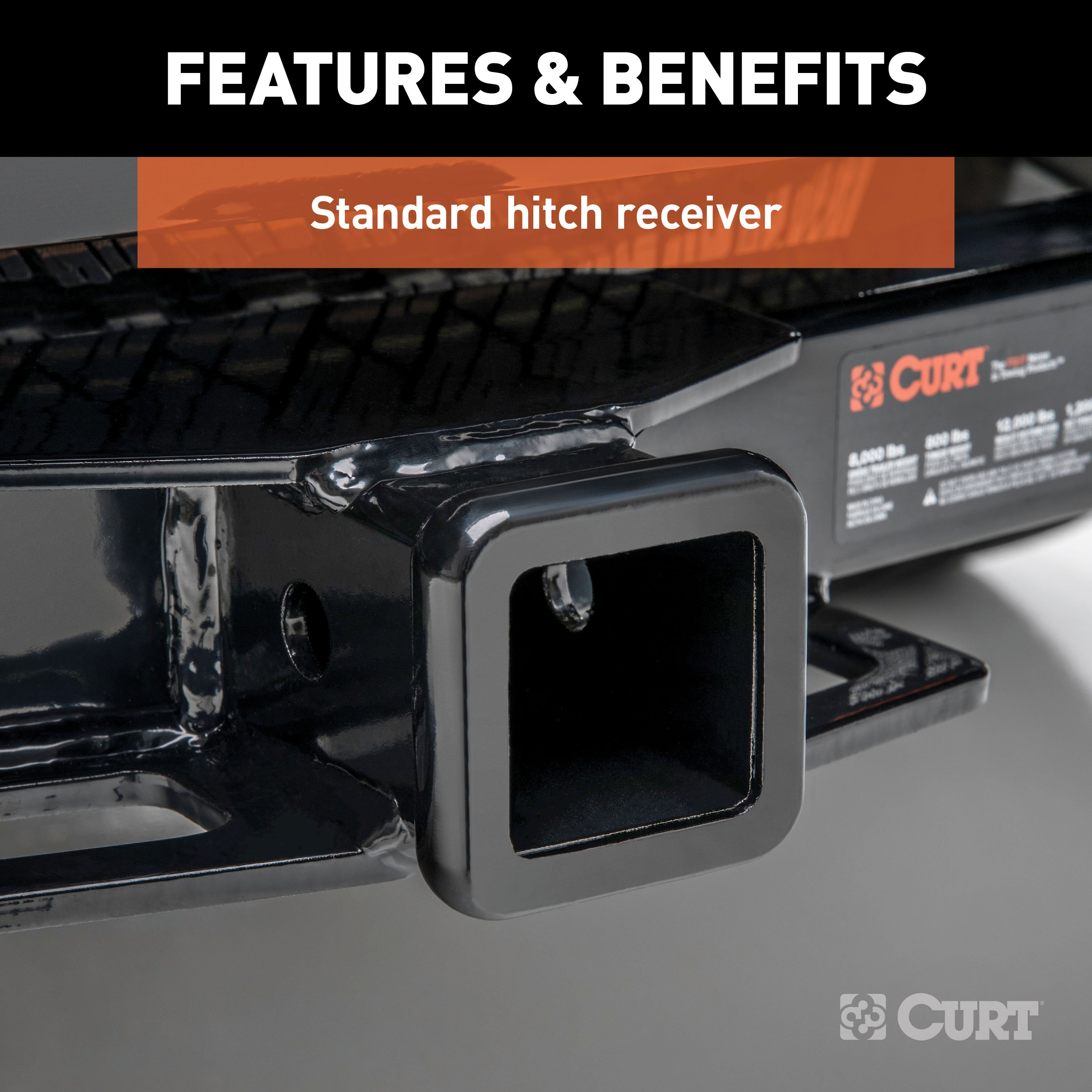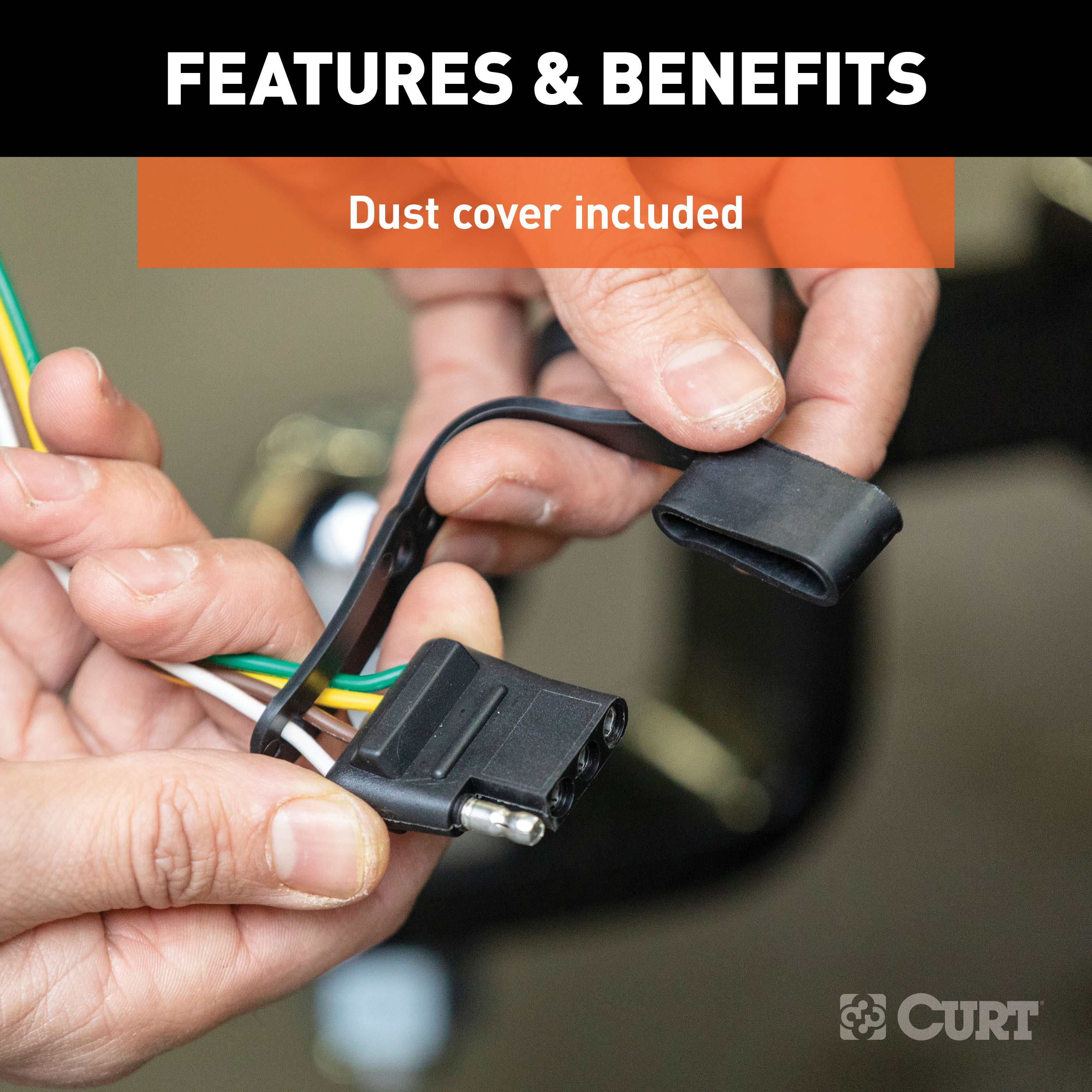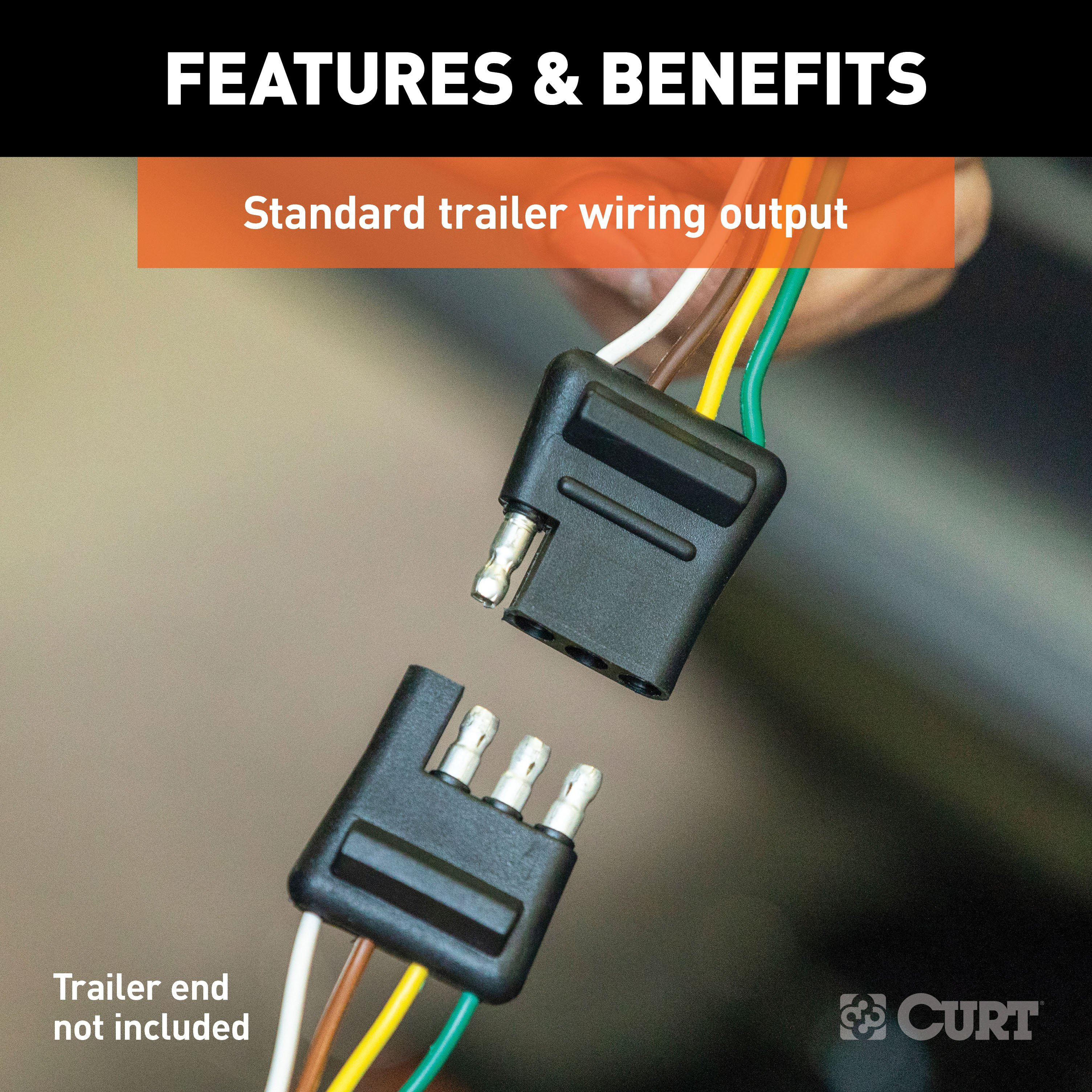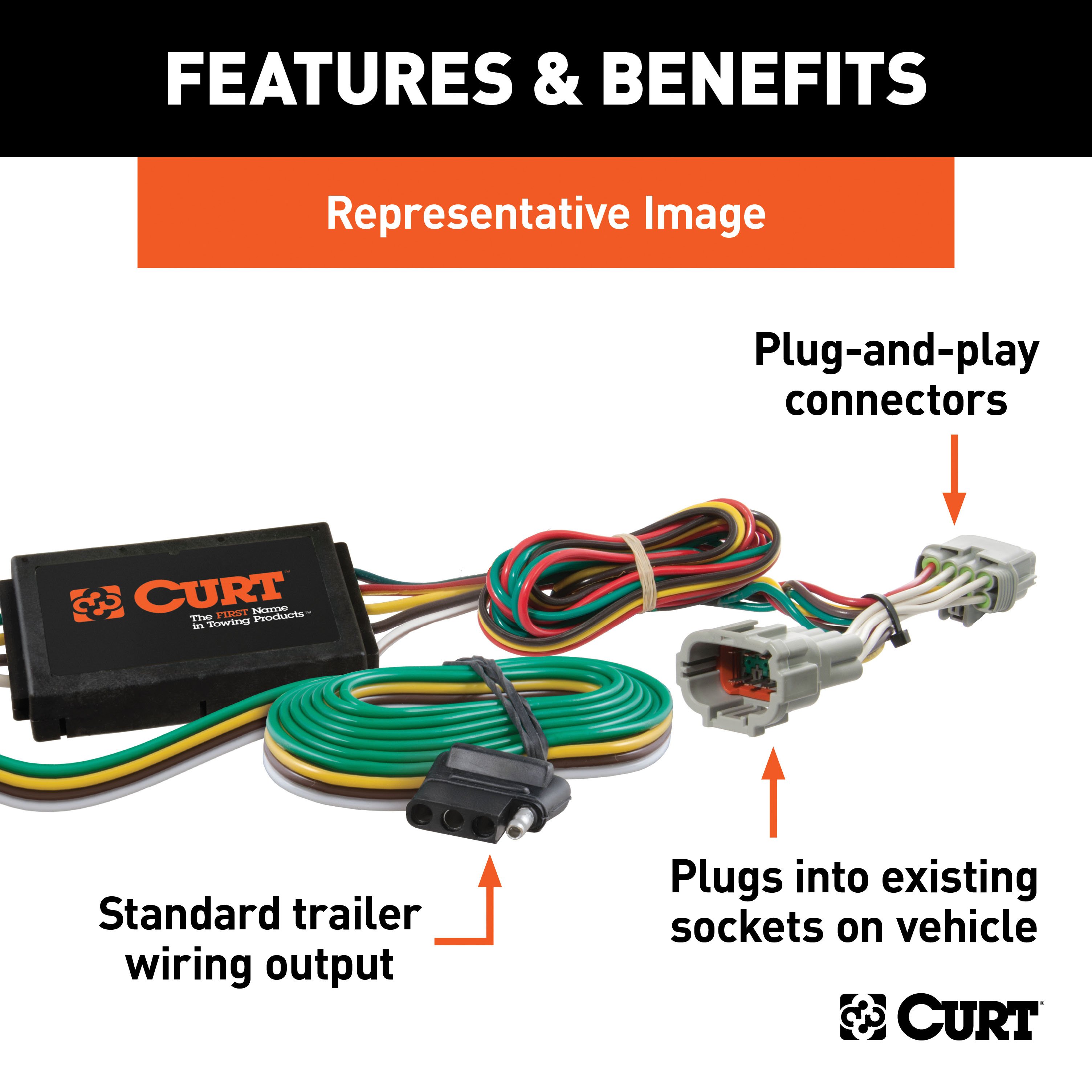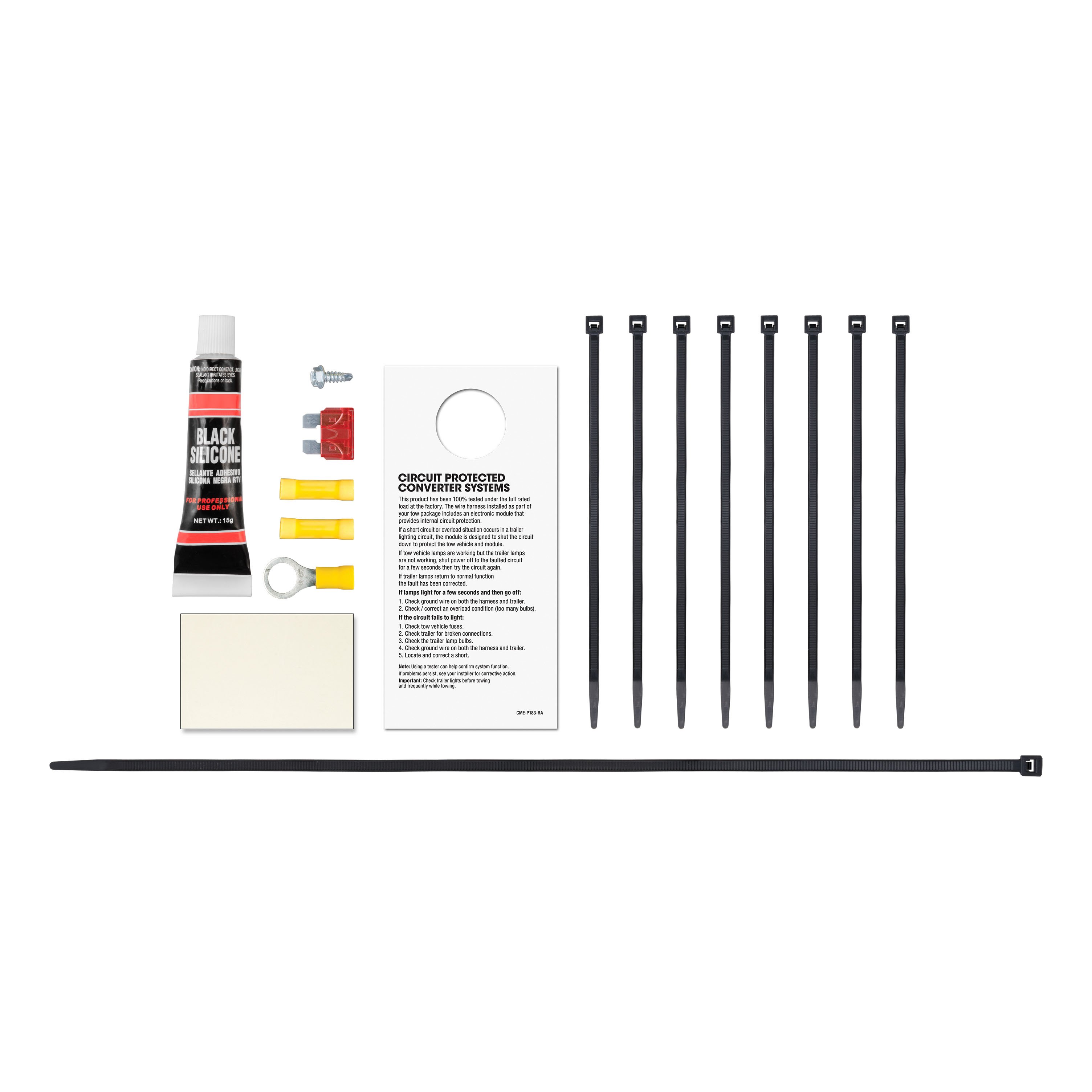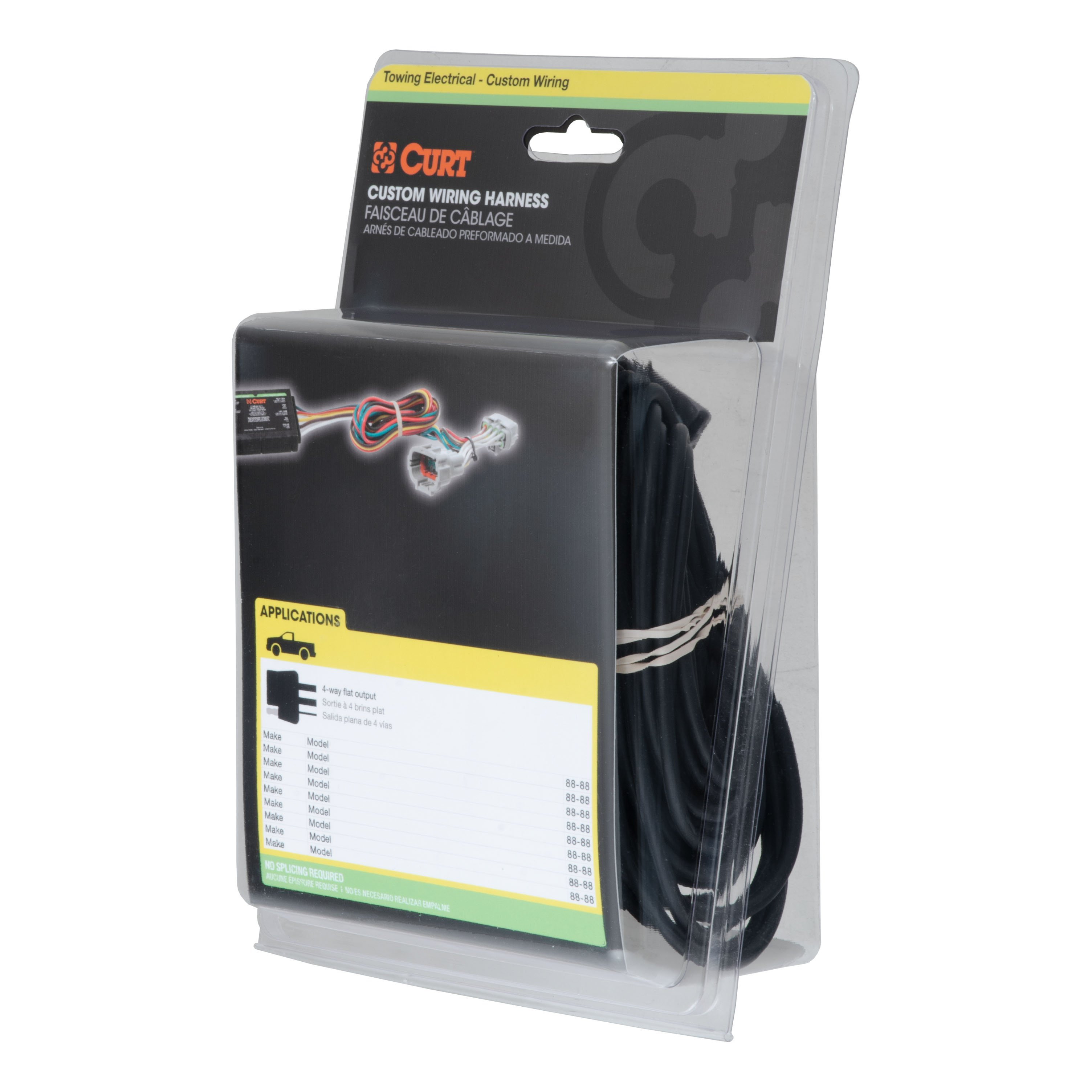Product Details
- Brand: Curt
- Model: 13186 56432-CH1227
- Includes: Class 3 Trailer Tow Hitch, Custom Wiring Harness
Compatibility Chart
Description
Get Expert Help
For 2019 Ford Escape Trailer Hitch + Wiring 4 Pin Fits All Models Curt 13186 56432 2 inch Tow Receiver Install Notes
Installation Instructions for 2013-Present Ford Escape SUV
Part Numbers:
- 13186
Tools Required:
- Torque Wrench
- Ratchet
- 6" Socket Extension
- 13mm Socket
- 10mm Socket
- 11/16" Socket
- Die Grinder
- Aviation Shears
- Safety Glasses
Step-by-Step Instructions:
Step 1: Lower Exhaust
- Remove (4) 8mm bolts from the muffler brackets and the forward rubber isolator.
- Return the (4) 8mm bolts to the owner.
Step 2: Trim Heat Shield
- Remove (1) fastener securing the heat shield to the bottom of the driver-side frame rail.
- Trim the heat shield to clear the mounting areas on the driver and passenger-side frame rails (refer to the trim diagram).
- Reattach the heat shield to the bottom of the driver-side frame rail after trimming.
Step 3: Enlarge Access Holes
- Enlarge the access holes on both sides of the frame to allow 7/16" carriage bolts to pass through.
Step 4: Fishwire Hardware
- Fishwire the 7/16" carriage bolts and SP7 spacers through the enlarged access holes and out the two rear-most mounting holes on both sides.
- Reverse fishwire the 7/16" carriage bolt and SP7 spacer into the enlarged access holes on both sides.
Note: Leave the fishwires attached to prevent losing the hardware into the frame rails.
Step 5: Position the Hitch
- Slide the hitch into position from the rear passenger side, guiding it over the exhaust.
- Feed the fishwires through the mounting holes while raising the hitch.
Step 6: Secure the Hitch
- Remove the fishwires from the carriage bolts in the bottom of the frame rails and loosely secure the hitch with 7/16" flange nuts.
- Pull the fishwires through the side mounting holes and secure them with 7/16" flange nuts.
Step 7: Attach Muffler Brackets
- Reattach the muffler brackets to the hitch's bottom using the provided M8-1.25 hex bolts and 5/16" washers.
Step 8: Torque Hardware
- Torque all 7/16" hardware to 70 ft-lbs.
- Torque all M8 hardware to 23 ft-lbs.
Step 9: Reattach Exhaust
- Reattach the rubber isolator removed in Step 1.
Hardware List:
- (6) 7/16" Fishwires
- (6) 7/16"-14 x 1-1/2" Carriage Bolts
- (6) .250 x 1.00 x 2.00" Square Hole Spacers (Part Number: CM-SP7)
- (6) 7/16"-14 Hex Flange Nuts
- (4) 5/16" Washers
- (4) M8-1.25 x 30mm Hex Bolts
Safety Notes:
- Safety glasses must be worn at all times during installation.
- Periodically check the hitch to ensure all fasteners are tight and structural components are sound.
Specifications:
- Weight Carrying Capacity:
- Maximum Trailer Weight: 3,500 lbs
- Maximum Tongue Weight: 350 lbs
- Weight Distribution Capacity:
- Maximum Trailer Weight: 5,000 lbs
- Maximum Tongue Weight: 500 lbs
- Compliant with SAE J684 and V.E.S.C. Regulation V-5
Installation Notes:
- Temporarily lower the exhaust.
- Trim the heat shield as necessary.
- Fishwire hardware installation is required.
- Enlarge access holes to accommodate bolts.
Warning:
All non-trailer loads must be supported by 18050 stabilizing straps. Failure to properly support non-trailer loads will void the product warranty.
Installation Instructions for 2013-Present Ford Escape SUV
Part Numbers:
- 13186
Tools Required:
- Torque Wrench
- Ratchet
- 6" Socket Extension
- 13mm Socket
- 10mm Socket
- 11/16" Socket
- Die Grinder
- Aviation Shears
- Safety Glasses
Step-by-Step Instructions:
Step 1: Lower Exhaust
- Remove (4) 8mm bolts from the muffler brackets and the forward rubber isolator.
- Return the (4) 8mm bolts to the owner.
Step 2: Trim Heat Shield
- Remove (1) fastener securing the heat shield to the bottom of the driver-side frame rail.
- Trim the heat shield to clear the mounting areas on the driver and passenger-side frame rails (refer to the trim diagram).
- Reattach the heat shield to the bottom of the driver-side frame rail after trimming.
Step 3: Enlarge Access Holes
- Enlarge the access holes on both sides of the frame to allow 7/16" carriage bolts to pass through.
Step 4: Fishwire Hardware
- Fishwire the 7/16" carriage bolts and SP7 spacers through the enlarged access holes and out the two rear-most mounting holes on both sides.
- Reverse fishwire the 7/16" carriage bolt and SP7 spacer into the enlarged access holes on both sides.
Note: Leave the fishwires attached to prevent losing the hardware into the frame rails.
Step 5: Position the Hitch
- Slide the hitch into position from the rear passenger side, guiding it over the exhaust.
- Feed the fishwires through the mounting holes while raising the hitch.
Step 6: Secure the Hitch
- Remove the fishwires from the carriage bolts in the bottom of the frame rails and loosely secure the hitch with 7/16" flange nuts.
- Pull the fishwires through the side mounting holes and secure them with 7/16" flange nuts.
Step 7: Attach Muffler Brackets
- Reattach the muffler brackets to the hitch's bottom using the provided M8-1.25 hex bolts and 5/16" washers.
Step 8: Torque Hardware
- Torque all 7/16" hardware to 70 ft-lbs.
- Torque all M8 hardware to 23 ft-lbs.
Step 9: Reattach Exhaust
- Reattach the rubber isolator removed in Step 1.
Hardware List:
- (6) 7/16" Fishwires
- (6) 7/16"-14 x 1-1/2" Carriage Bolts
- (6) .250 x 1.00 x 2.00" Square Hole Spacers
- (6) 7/16"-14 Hex Flange Nuts
- (4) 5/16" Washers
- (4) M8-1.25 x 30mm Hex Bolts
Safety Notes:
- Safety glasses must be worn at all times during installation.
- Periodically check the hitch to ensure all fasteners are tight and structural components are sound.
Specifications:
- Weight Carrying Capacity:
- Maximum Trailer Weight: 3,500 lbs
- Maximum Tongue Weight: 350 lbs
- Weight Distribution Capacity:
- Maximum Trailer Weight: 5,000 lbs
- Maximum Tongue Weight: 500 lbs
- Compliant with SAE J684 and V.E.S.C. Regulation V-5
Installation Notes:
- Temporarily lower the exhaust.
- Trim the heat shield as necessary.
- Fishwire hardware installation is required.
- Enlarge access holes to accommodate bolts.
Warning:
All non-trailer loads must be supported by stabilizing straps. Failure to properly support non-trailer loads will void the product warranty.
General Information:
Attention:
This is a summary of the installation procedure. For complete installation instructions, including diagrams and detailed information from the manufacturer, please download the full installation PDF.
Technical Support:
For technical support and assistance, our team of experts is available to help. You can reach our tech support by visiting www.trailerjacks.com or calling 877-869-6690.
Warranty Information:
For complete warranty instructions, please download the full installation PDF.
Installation Instructions for Ford Escape
Part Numbers:
- 56432
Wiring Access Locations:
- S1: Behind driver side taillight housing
- S2: Behind passenger side taillight housing
Tools Required:
- Ratchet
- 8mm and 10mm sockets
- Socket extension
- Wire cutter
- Wire stripper
- Wire crimper
- Torx bit (T-25)
- Electrical tape
- Small flathead screwdriver
- Panel trim removal tool
Step-by-Step Instructions:
-
Disconnect the Battery:
- Locate the vehicle battery (refer to the owner’s manual for location).
- Disconnect the negative battery terminal and secure it away from the battery during installation.
-
Access the Taillights:
- Open the vehicle hatch and use a small flathead screwdriver to remove the fastener covers in the taillights.
- Using an 8mm socket, remove the two fasteners from the taillight.
- Carefully pull the taillight straight back from the vehicle and disconnect it from the wiring harness. Set the taillight aside.
- Repeat this step for the passenger side.
-
Prepare the Trunk Area:
- Remove all trunk floor coverings to expose the spare tire.
- Disconnect any electrical components in the foam bins located at the back of the rear seats.
- Remove the four push fasteners (two per side) in the foam bins using a panel trim removal tool. Remove the foam bins.
-
Remove the Scuff Plate:
- Using a T-25 Torx bit, remove the two screw fasteners securing the scuff plate.
- Remove the two push fasteners with a panel trim removal tool, then pull the scuff plate straight up to remove it.
-
Route the Wiring Harness:
- Starting on the driver side, use a panel trim removal tool to loosen the side wall panels to access the backside of the vehicle body.
- Loosen the rubber grommet located behind the taillight. Carefully cut the grommet using a wire cutter.
- Route the T-connector end with the yellow wire through the grommet hole and plug it into the factory wiring harness.
-
Secure the Converter Box and Ground Wire:
- Locate a clean, flat surface out of the path of spray and debris to adhere the black converter box using the provided double-sided tape.
- Find a grounding point near the converter box, such as an existing screw or bolt in the vehicle frame, or drill a 3/32" pilot hole.
- Remove any rust, dirt, or paint at the grounding point, then secure the white ground wire using the ring terminal and provided ground screw.
-
Complete Passenger-Side Installation:
- Reinstall the grommet into the hole and seal the cut with the provided silicone sealant.
- Route the T-connector with the green wire to the passenger side, following the same process as the driver side (steps 5 and 6).
-
Route the Power Wire:
- Route the black power wire from the vehicle battery as described in the "Powered Converter Lead Instruction Sheet."
- Avoid pinch points and hot surfaces during routing.
-
Install and Secure the 4-Flat Connector:
- When in use, route the 4-flat connector to the center of the vehicle and out of the trunk.
- When not in use, roll up the connector and store it inside the trunk in a safe location.
- Secure any loose wires with the provided cable ties.
-
Reinstall Components and Test:
- Reinstall all removed items, including the taillights, scuff plate, foam bins, and trunk floor coverings.
- Reconnect the negative battery terminal.
- Install the provided 4-flat dust cover to prevent corrosion.
- Test the system with a test light, 4-flat tester, or functioning trailer.
Safety Notes:
- Warning: Check for hidden items behind or under any surface before drilling to avoid damage or injury.
- Do not exceed the product rating or the tow vehicle lamp load rating.
Specifications:
- Signal circuits: 3.0 amps per side
- Tail/Running circuits: 6.0 amps total
- Use only with 12-volt negative ground systems.
Maintenance:
- Periodically inspect all wires and connections to ensure there is no visible damage or loose connections.
Manufacturer Notes:
- Follow the instructions thoroughly to ensure proper functionality.
- Test the harness system before completing the installation process.
Installation Instructions
Part Numbers:
- 56432
Wiring Access Locations:
- S1: Behind driver side taillight housing
- S2: Behind passenger side taillight housing
Tools Required:
- Ratchet
- 8mm and 10mm sockets
- Socket extension
- Wire cutter
- Wire stripper
- Wire crimper
- Torx bit (T-25)
- Electrical tape
- Small flathead screwdriver
- Panel trim removal tool
Step-by-Step Instructions:
-
Disconnect the Battery:
- Locate the vehicle battery (refer to the owner’s manual for location).
- Disconnect the negative battery terminal and secure it away from the battery during installation.
-
Access the Taillights:
- Open the vehicle hatch and use a small flathead screwdriver to remove the fastener covers in the taillights.
- Using an 8mm socket, remove the two fasteners from the taillight.
- Carefully pull the taillight straight back from the vehicle and disconnect it from the wiring harness. Set the taillight aside.
- Repeat this step for the passenger side.
-
Prepare the Trunk Area:
- Remove all trunk floor coverings to expose the spare tire.
- Disconnect any electrical components in the foam bins located at the back of the rear seats.
- Remove the four push fasteners (two per side) in the foam bins using a panel trim removal tool. Remove the foam bins.
-
Remove the Scuff Plate:
- Using a T-25 Torx bit, remove the two screw fasteners securing the scuff plate.
- Remove the two push fasteners with a panel trim removal tool, then pull the scuff plate straight up to remove it.
-
Route the Wiring Harness:
- Starting on the driver side, use a panel trim removal tool to loosen the side wall panels to access the backside of the vehicle body.
- Loosen the rubber grommet located behind the taillight. Carefully cut the grommet using a wire cutter.
- Route the T-connector end with the yellow wire through the grommet hole and plug it into the factory wiring harness.
-
Secure the Converter Box and Ground Wire:
- Locate a clean, flat surface out of the path of spray and debris to adhere the black converter box using the provided double-sided tape.
- Find a grounding point near the converter box, such as an existing screw or bolt in the vehicle frame, or drill a 3/32" pilot hole.
- Remove any rust, dirt, or paint at the grounding point, then secure the white ground wire using the ring terminal and provided ground screw.
-
Complete Passenger-Side Installation:
- Reinstall the grommet into the hole and seal the cut with the provided silicone sealant.
- Route the T-connector with the green wire to the passenger side, following the same process as the driver side (steps 5 and 6).
-
Route the Power Wire:
- Route the black power wire from the vehicle battery as described in the "Powered Converter Lead Instruction Sheet."
- Avoid pinch points and hot surfaces during routing.
-
Install and Secure the 4-Flat Connector:
- When in use, route the 4-flat connector to the center of the vehicle and out of the trunk.
- When not in use, roll up the connector and store it inside the trunk in a safe location.
- Secure any loose wires with the provided cable ties.
-
Reinstall Components and Test:
- Reinstall all removed items, including the taillights, scuff plate, foam bins, and trunk floor coverings.
- Reconnect the negative battery terminal.
- Install the provided 4-flat dust cover to prevent corrosion.
- Test the system with a test light, 4-flat tester, or functioning trailer.
Safety Notes:
- Warning: Check for hidden items behind or under any surface before drilling to avoid damage or injury.
- Do not exceed the product rating or the tow vehicle lamp load rating.
Specifications:
- Signal circuits: 3.0 amps per side
- Tail/Running circuits: 6.0 amps total
- Use only with 12-volt negative ground systems.
Warranty Information:
- This product is covered by a limited warranty. For complete warranty instructions, please download the full installation PDF.
Technical Support:
- For technical support and assistance, our team of experts is available to help. You can reach our tech support by visiting www.trailerjacks.com or calling 877-869-6690.
Attention: This is a summary of the installation procedure. For complete installation instructions, including diagrams and detailed information from the manufacturer, please download the full installation PDF.
Maintenance:
- Periodically inspect all wires and connections to ensure there is no visible damage or loose connections.
Manufacturer Notes:
- Follow the instructions thoroughly to ensure proper functionality.
- Test the harness system before completing the installation process.























































































